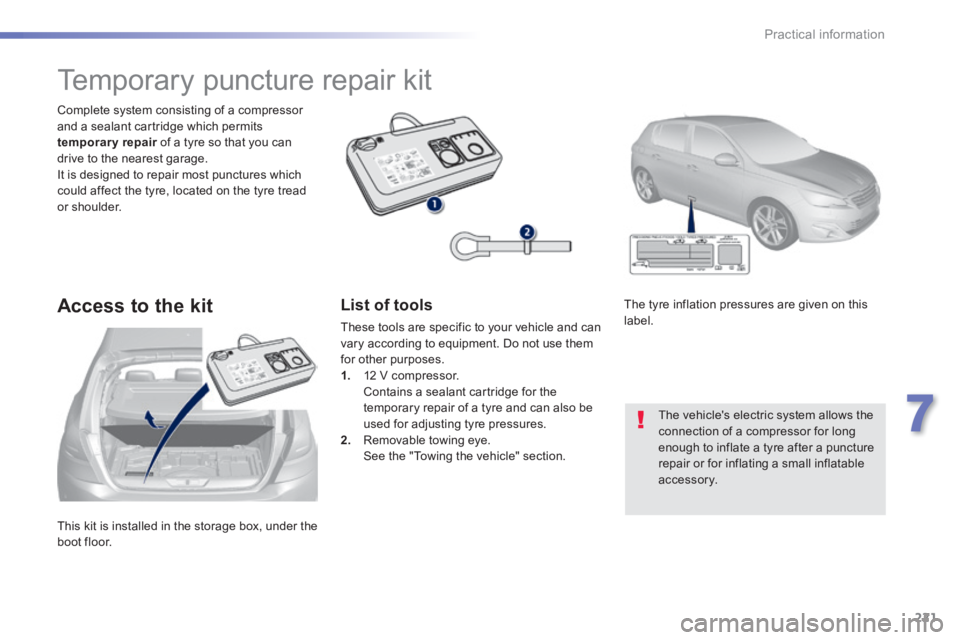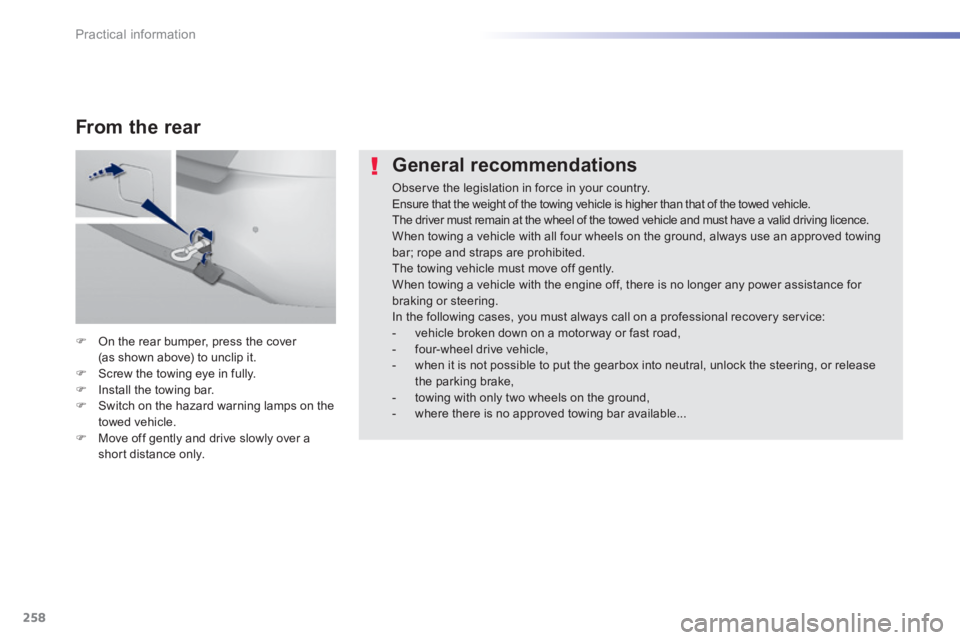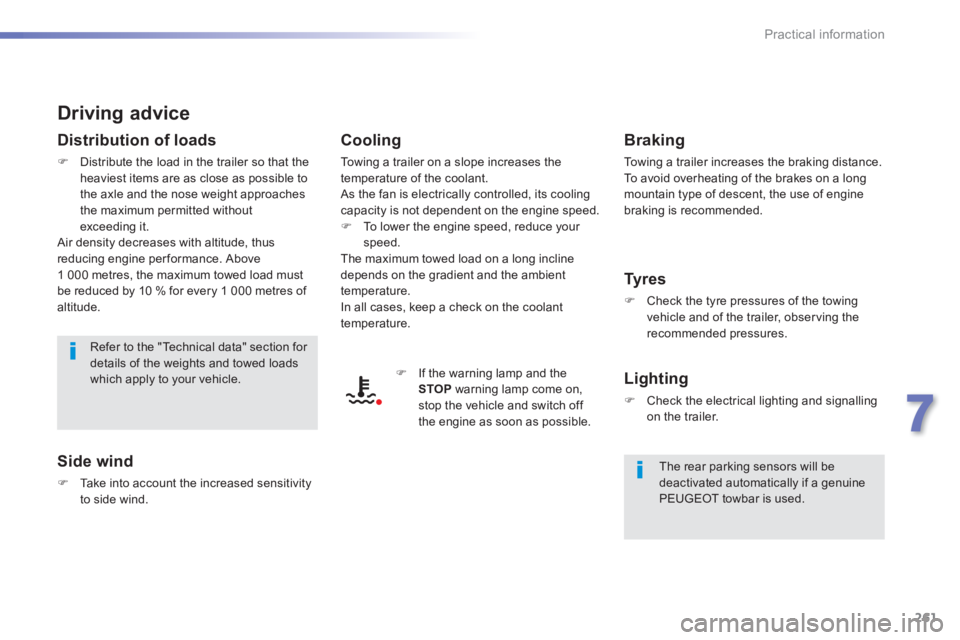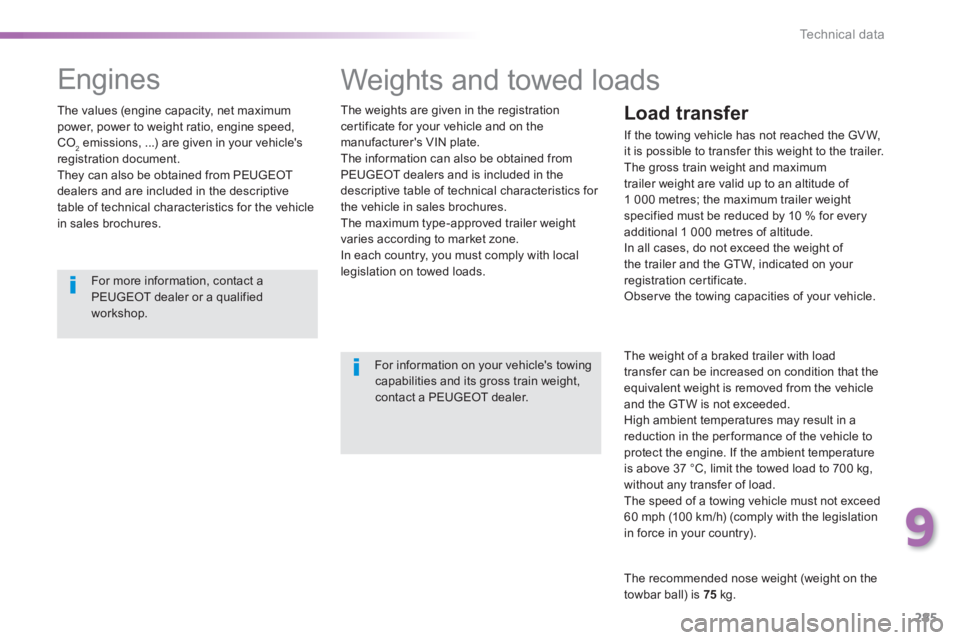Page 223 of 400

221
7
Practical information
This kit is installed in the storage box, under the boot floor.
Complete system consisting of a compressor and a sealant cartridge which permits temporary repair of a tyre so that you can temporary repair of a tyre so that you can temporary repairdrive to the nearest garage. It is designed to repair most punctures which could affect the tyre, located on the tyre tread or shoulder.
Temporary puncture repair kit
Access to the kit List of tools
These tools are specific to your vehicle and can vary according to equipment. Do not use them for other purposes. 1. 12 V compressor. Contains a sealant cartridge for the temporary repair of a tyre and can also be used for adjusting tyre pressures. 2. Removable towing eye. See the "Towing the vehicle" section.
The tyre inflation pressures are given on this label.
The vehicle's electric system allows the connection of a compressor for long enough to inflate a tyre after a puncture repair or for inflating a small inflatable accessory.
Page 229 of 400
227
7
Practical information
Changing a wheel
The tools are installed in the boot under the f l o o r.
Access to the tools
List of tools
These tools are specific to your vehicle and can vary according to the level of equipment. Do not use them for other purposes. 1. Wheelbrace. For removing the wheel trim and removing the wheel bolts. 2. Jack with integral handle. For raising the vehicle.
3. "Bolt cover" tool. For removing the bolt protectors (covers) on alloy wheels. 4. Socket for the security bolts (located in the glove box). For adapting the wheelbrace to the special "security" bolts. 5. Towing eye. See "Towing the vehicle".
Procedure for changing a faulty wheel for the spare wheel using the tools provided with the vehicle.
Page 259 of 400
257
7
Practical information
Towing the vehicle Procedure for having your vehicle towed or for towing another vehicle using a removable towing eye.
Access to the tools
The towing eye is installed in the boot under the floor. To gain access to it: open the boot, raise the floor, remove the towing eye from the holder.
Put the gear lever into neutral. The failure to follow this requirement may lead to damage to components of the braking system and the lack of braking assistance on restarting the engine.
On the front bumper, press the cover (as shown above) to unclip it. Screw the towing eye in fully. Install the towing bar. Switch on the hazard warning lamps on the towed vehicle. Move off gently and drive slowly over a short distance only.
From the front
Page 260 of 400

258
Practical information
General recommendations
Observe the legislation in force in your country. Ensure that the weight of the towing vehicle is higher than that of the towed vehicle. The driver must remain at the wheel of the towed vehicle and must have a valid driving licence. When towing a vehicle with all four wheels on the ground, always use an approved towing bar; rope and straps are prohibited. The towing vehicle must move off gently. When towing a vehicle with the engine off, there is no longer any power assistance for braking or steering. In the following cases, you must always call on a professional recovery service: - vehicle broken down on a motor way or fast road, - four-wheel drive vehicle, - when it is not possible to put the gearbox into neutral, unlock the steering, or release the parking brake, - towing with only two wheels on the ground, - where there is no approved towing bar available...
On the rear bumper, press the cover (as shown above) to unclip it. Screw the towing eye in fully. Install the towing bar. Switch on the hazard warning lamps on the towed vehicle. Move off gently and drive slowly over a short distance only.
From the rear
Page 261 of 400
259
7
Practical information
Very cold climate screen
Before fitting or removing the screen, ensure that the engine is off and the cooling fan has stopped. It is recommended that the screen be fitted and removed by a PEUGEOT dealer or a qualified workshop.
Fitting
Offer up the screen to the front of the top section of the front bumper upper grille. Press on the screen to engage its fixing clips.
Removal
Use a screwdriver as a lever to unclip each retaining clip in turn.
Do not forget to remove the very cold climate screen: - when the ambient temperature exceeds 10° C (for example: in summer, ...), - when towing, - at speeds above 75 mph (120 km/h).
Removable protective screen which prevents the accumulation of snow at the radiator cooling fan.
Page 262 of 400
260
Practical information
Towing a trailer
We recommend the use of genuine PEUGEOT towbars and their harnesses that have been tested and approved from the design stage of your vehicle, and that the fitting of the towbar is
entrusted to a PEUGEOT dealer or a qualified workshop. If the towbar is not fitted by a PEUGEOT dealer, it is imperative that it is fitted in accordance with the vehicle manufacturer's instructions. Towbar suitable for the attachment of a trailer or installation of a bicycle carrier, with additional lighting and signalling.
Blanking cover
When towing, you must remove the blanking cover if your vehicle has one. Contact a PEUGEOT dealer or a qualified workshop for this. Driving with a trailer places greater demands on the towing vehicle and the driver must take particular care.
Your vehicle is primarily designed for transporting people and luggage, but it may also be used for towing a trailer.
The cover is located behind the lower air intake grille.
Page 263 of 400

261
7
Practical information
Driving advice
Distribution of loads
Distribute the load in the trailer so that the heaviest items are as close as possible to the axle and the nose weight approaches the maximum permitted without
exceeding it. Air density decreases with altitude, thus reducing engine performance. Above 1 000 metres, the maximum towed load must be reduced by 10 % for every 1 000 metres of altitude.
Side wind
Take into account the increased sensitivity to side wind.
Cooling
Towing a trailer on a slope increases the temperature of the coolant. As the fan is electrically controlled, its cooling capacity is not dependent on the engine speed.
To lower the engine speed, reduce your speed. The maximum towed load on a long incline depends on the gradient and the ambient temperature. In all cases, keep a check on the coolant temperature.
If the warning lamp and the STOP warning lamp come on, stop the vehicle and switch off the engine as soon as possible.
Braking
Towing a trailer increases the braking distance. To avoid overheating of the brakes on a long mountain type of descent, the use of engine braking is recommended.
Ty r e s
Check the tyre pressures of the towing vehicle and of the trailer, observing the recommended pressures.
Lighting
Check the electrical lighting and signalling on the trailer.
The rear parking sensors will be deactivated automatically if a genuine PEUGEOT towbar is used.
Refer to the "Technical data" section for details of the weights and towed loads which apply to your vehicle.
Page 287 of 400

285
9
Technical data
Weights and towed loads
The weights are given in the registration certificate for your vehicle and on the manufacturer's VIN plate. The information can also be obtained from PEUGEOT dealers and is included in the descriptive table of technical characteristics for the vehicle in sales brochures. The maximum type-approved trailer weight
varies according to market zone. In each country, you must comply with local legislation on towed loads.
For information on your vehicle's towing capabilities and its gross train weight, contact a PEUGEOT dealer.
Load transfer
If the towing vehicle has not reached the GV W, it is possible to transfer this weight to the trailer. The gross train weight and maximum trailer weight are valid up to an altitude of 1 000 metres; the maximum trailer weight specified must be reduced by 10 % for every additional 1 000 metres of altitude. In all cases, do not exceed the weight of the trailer and the GTW, indicated on your registration certificate. Observe the towing capacities of your vehicle.
The weight of a braked trailer with load transfer can be increased on condition that the equivalent weight is removed from the vehicle and the GTW is not exceeded. High ambient temperatures may result in a reduction in the per formance of the vehicle to protect the engine. If the ambient temperature is above 37 °C, limit the towed load to 700 kg, without any transfer of load. The speed of a towing vehicle must not exceed 60 mph (100 km/h) (comply with the legislation
in force in your country).
The recommended nose weight (weight on the
towbar ball) is 75 kg.
Engines
The values (engine capacity, net maximum power, power to weight ratio, engine speed, CO2 emissions, ...) are given in your vehicle's registration document. They can also be obtained from PEUGEOT dealers and are included in the descriptive table of technical characteristics for the vehicle in sales brochures.
For more information, contact a PEUGEOT dealer or a qualified workshop.